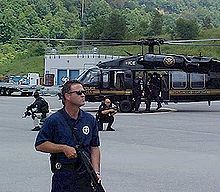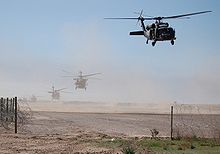From Wikipedia, the free encyclopedia
Metonymic use of the phrase black helicopters sometimes occurs in reference to conspiracy theories in general.
Contents
Overview

Armed United States Marshals Service officers stand guard around a black helicopter (in this case, a UH-60 Blackhawk)
Jim Keith wrote two books on the subject: Black Helicopters Over America: Strikeforce for the New World Order (1995), and Black Helicopters II : The End Game Strategy (1998).[citation needed]
Media attention to black helicopters increased in February 1995, when first-term Republican northern Idaho Representative Helen Chenoweth charged that armed federal agents were landing black helicopters on Idaho ranchers' property to enforce the Endangered Species Act. "I have never seen them," Chenoweth said in an interview in The New York Times. "But enough people in my district have become concerned that I can't just ignore it. We do have some proof."[6] Chenoweth made the charges at a press conference without ever consulting with the Department of the Interior.[citation needed]
The black helicopters theory resonates well with the belief held by some in the militia movement that troops from the United Nations might invade the United States. The John Birch Society published an article in The New American detailing how the existence of the covert aircraft was mostly the product of possible visual errors and a tendency towards overboard caution.[7]
Possible explanations

Sikorsky UH-60 Black Hawk helicopters flying in Iraq
- At least some sightings of black helicopters are very likely to have been helicopters on exercises and/or missions. Some of them are flown by units of the Army National Guard and are actually black (not dark olive or chocolate brown) when seen in ordinary light. U.S. Customs and Border Protection operates a dozen black-and-gold UH-60 Black Hawk helicopters.[8] The American military does in fact operate helicopters painted in black or dark colors, particularly the Pave Low which was optimized for long-range stealthy insertion and extraction of personnel, including combat search and rescue.
- U.S. Army and National Guard helicopters painted olive drab will appear to be black in the reddish light of dawn or dusk, or under other low light conditions during the day when their shadow side is viewed against the sky with the naked eye. The Army's 160th Special Operations Aviation Regiment use helicopters primarily painted black.
- In the early 1970s, the CIA operated a black Hughes 500P helicopter in Vietnam, in order to place phone taps.[9] Test flights began at Culver City, California, in 1971.[10] It was noted for its low noise emission, and given the nickname "The Quiet One." After the mission assigned to it had been completed, the helicopter was returned to California and had most of the special features stripped out by mechanics. It was transferred to the ownership of the Pacific Corporation of Washington, D.C.[11]
- The U.S. Army regularly conducts both exercises and operational missions in American airspace. Some of these exercises have taken place in densely populated cities, including Los Angeles, New York, Detroit, San Francisco, Oakland, Chicago[12] and Washington, D.C. Most operational missions are tasked in narcotics interdiction in the American Southwest and out of Florida and Puerto Rico. By extensive use of IR, Radar, GPS and night vision devices, as well as other classified means, they are able to fly in zero visibility conditions with no running lights[citation needed]. At this high intensity level of operation, training is necessarily almost as dangerous to pilots, other air traffic, and the public as actual combat. Frequent practice is necessary to retain proficiency. Frequent practice results in frequent sightings by concerned members of the public.

The US Customs and Border Protection organization uses black UH-60 Sikorsky helicopters
- Many defense contractors and helicopter manufacturers also conduct public flight testing of aircraft and components or fly aircraft in public view to test ranges or other corporate airfields for training or demonstrations. Occasionally, some of these aircraft will be made for military clients and are painted in black or dark colors.
- In the UK, police helicopters are required by the CAA to be marked in a standard 'high conspicuosity' paint scheme, to make them more visible and avoid the possibility of air proximity hazards with other low flying aircraft. This paint scheme, also used by UK military training helicopters, requires them to be black on the sides and underneath, and yellow on top. When seen from the ground, these helicopters are black but this is to make them more visible against the sky as a safety feature (and yellow against the ground when seen from above).
- Many US law enforcement agencies use black helicopters for surveillance, transportation, and patrol. Some of the agencies that use them are U.S. Customs and Border Protection, Immigration and Customs Enforcement, the US Marshals Service, the Drug Enforcement Administration and the Federal Bureau of Investigation.
Pejorative use
The term has also been used to ridicule other conspiracy theories or conspiracy theorists. For instance, a Slate article on basketball refereeing, said: "In the wake of this scandal, every game will be in question, and not only by fans disposed to seeing black helicopters outside the arena."[13] Vice President Joe Biden had recourse to the term in a speech attacking the National Rifle Association during the 2013 White House campaign for background checks on all gun purchasers, saying, "The black helicopter crowd is really upset. It's kind of scary, man." 14In popular culture
| This article does not cite any references or sources. (July 2013) |
In the 1997 movie Conspiracy Theory, starring Mel Gibson as a New York City cabdriver, out of whose many conspiracy theories one turns out to be true and he's chased by an obscure US Intelligence Agency; after one of his purchases of The Catcher in the Rye, they pursue him using black helicopters. The 1983 movie Blue Thunder is a classical example of use of a black helicopter created specially for surveillance and spying on citizens.
Canadian singer Matthew Good has a song called "Black Helicopter" on his 2007 album Hospital Music. Underground Hip Hop group Non Phixion have a track on their 2002 album release The Future Is Now called "Black Helicopters".
In the 2007 film Transformers, the government agency Sector 7 used black helicopters to hunt down the robotic Autobots.

No comments:
Post a Comment